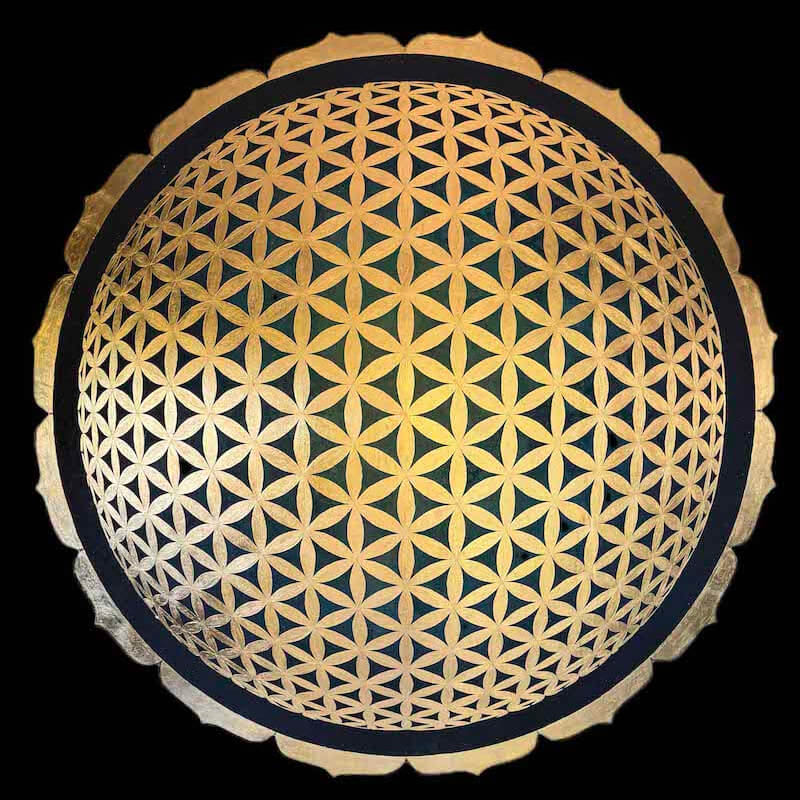
Sacred Geometry: How Modern Science Rediscovers the Universal Patterns of the Universe
Sacred geometry represents one of the most extraordinary bridges between modern science and ancient wisdom. Through universal mathematical patterns found in nature, art, and spiritual traditions, this discipline reveals the deep structure of the cosmos: an invisible order that connects the micro and the macro, the material and the spiritual.
More than an aesthetic or mystical concept, sacred geometry is a universal language of creation, a map that describes how energy organizes into form, proportion, and harmony.
The Universal Language of Creation
Since the earliest civilizations, humans have intuited that geometry is linked to the divine. The Egyptians used it in pyramid architecture, the Greeks made it the foundation of art and philosophy, and Eastern cultures integrated it into temples, mandalas, and yantras.
Plato called it "the language of the soul of the world," asserting that geometric solids represented the fundamental elements of the universe: earth, water, air, fire, and ether.
Today, science confirms what ancient traditions intuitively knew: the universe is built on repeating geometric patterns, expressed at all scales, from DNA molecules to planetary orbits.
Geometric Patterns in Nature: Scientific Evidence
Nature is imbued with a mathematical logic that reflects an underlying intelligence.
The Fibonacci Spirals
Fibonacci spirals, following the famous numerical sequence (1, 1, 2, 3, 5, 8, 13…), appear in mollusk shells, sunflower seed arrangements, snail horns, and the structure of galaxies.
The Golden Ratio
The golden ratio, or phi (1.618…), appears in the human body, tree branches, and crystalline formations. This ratio is associated with visual harmony and is considered a reflection of cosmic balance.
Water Crystals and Vibration
Water crystals, as shown by researcher Masaru Emoto, adopt harmonious hexagonal shapes when exposed to positive vibrations, such as music or words of love. While his work has been debated in scientific circles, it opened discussion about the influence of vibration and intention on matter.
Fractal Patterns in the Cosmos
At an astronomical level, fractal patterns repeat in cloud formations, mountains, and galaxies. Fractal geometry, described by Benoît Mandelbrot, shows that the universe is not chaotic but follows self-similar principles where each part reflects the whole.
Thus, science begins to intertwine with spirituality by recognizing that geometric order is the signature of creation.
Sacred Geometry as a Bridge Between Science and Consciousness
Quantum physics and contemporary cosmology have revealed that matter is not solid but a condensed form of vibrating energy. Everything we perceive as "real" is composed of frequency fields interacting in an invisible fabric.
In this context, sacred geometry acts as the blueprint for these interactions: it describes how energy organizes to give rise to matter and consciousness.
The Research of Robert Edward Grant
Robert Edward Grant, an independent researcher and contemporary author, has devoted his studies to demonstrating how sacred geometry connects the structure of the universe with human consciousness. According to Grant, form is the manifestation of universal thought, and each geometric pattern encodes information the human brain can intuitively recognize, even without rational understanding.
Grant explains that relationships between numbers, angles, and proportions are the foundations of both subatomic particles and planetary systems. From his perspective, understanding sacred geometry is understanding the source code of the universe, a point where modern science and ancient wisdom converge with remarkable coherence.
The Spiritual Meaning of Key Sacred Geometry Symbols
Sacred geometric symbols are found in all cultures, from ancient Egypt to Vedic India, Mayan temples, and Gothic cathedrals. Each carries symbolic and energetic teachings.
The Flower of Life
Perhaps the most universal pattern, formed by overlapping circles creating a harmonious grid. It is said to contain all forms of the universe, including the Platonic solids. It represents the unity of all creation and the interconnection of everything that exists.
Metatron's Cube
Derived from the Flower of Life, it integrates the five Platonic solids—tetrahedron, cube, octahedron, dodecahedron, and icosahedron. It is considered an energetic protective field and a model of the subatomic structure of matter.
The Sri Yantra
One of the oldest symbols of Hinduism. Its interlocking triangles represent the union of masculine and feminine, the balance between energy and consciousness. It is used as a meditation tool to connect with the universe's creative principle.
The Toroid
Describes the continuous energy flow spiraling from the center outward and back to the center. It is present in electromagnetic fields, the human heart, and the movement of the universe. It represents self-generation and the eternal flow of life.
The Five Elements
In many traditions, the Platonic solids correspond to the natural elements (earth, air, water, fire, and ether), reminding us of the deep relationship between geometry and vital processes.
Tibetan Cosmology
Incorporates geometric diagrams representing planes of existence and levels of consciousness. Each shape, line, and color serves as a symbolic guide toward spiritual expansion.
These symbols are not mere illustrations but encoded frequencies that can influence the mind and environment. Prolonged contemplation generates a state of cerebral and emotional coherence, just as harmonic music influences brainwaves.
Resonance Between Form, Energy, and Consciousness
Resonance is a fundamental principle in physics: it occurs when one frequency induces vibration in another. Our brain, heart, and energy field respond to geometric patterns because they share the same mathematical foundation of nature. Sacred geometry images, therefore, not only stimulate the senses but also synchronize mind and body with universal order.
Studies from the HeartMath Institute have shown that positive emotions and harmonic visual forms generate a state of psychophysiological coherence, where heart rhythm, breathing, and brainwaves synchronize. This balance improves mental clarity, reduces stress, and enhances intuitive perception.
In other words, exposure to harmonic geometric patterns reminds our body how to return to its natural frequency of balance.
Applying Sacred Geometry in Daily Life
Integrating sacred geometry into everyday life requires no technical knowledge or specific beliefs. It is, above all, a practice of reconnection with harmony.
Observe patterns in nature
Looking at flowers, snowflakes, or seashells with conscious awareness helps perceive the order hidden behind apparent chaos.
Meditate with geometric symbols
Placing a mandala or sacred figure in front of you and contemplating it for a few minutes helps quiet the mind and align energy. The circular repetition of the pattern induces alpha brainwaves, associated with deep relaxation.
Decorate with sacred geometry
Having artwork inspired by these patterns at home or at work serves as a constant reminder of balance. Colors and shapes generate a vibrational field that influences the environment and emotional state.
Create your own designs
Drawing or painting geometric figures awakens the connection between brain hemispheres, enhancing creativity and concentration. It is a form of active meditation that channels energy through art.
Recognize geometry in your own body
From facial symmetry to the golden ratio in DNA, our body is a microcosm reflecting the universe's design. Understanding it invites us to honor the natural perfection we are.
Science, Spirituality, and Unity: A New Vision of the Universe
For centuries, science and spirituality seemed to speak different languages. However, in recent decades, both disciplines have begun converging on one point: awareness of the underlying order of the universe.
Quantum physics teaches that the observer influences the observed, that matter responds to consciousness. Ancient spirituality maintains that the universe reflects the spirit, a living creation of conscious energy.
Sacred geometry emerges as the union point between these views. It is the visible form of spirit, the mathematical imprint of consciousness in matter. Each spiral, triangle, or circle reminds us that we are not separate from the cosmos but active participants in its design. Contemplating these patterns allows us to not only admire their beauty but also remember who we are.
Conclusion: The Universe as a Living Work of Art
Sacred geometry is not only present in ancient temples or esoteric texts; it exists in every cell, atom, and thought. It is proof that the universe has both form and soul, science and purpose.
Observing it consciously invites participation in the mystery of creation. Applying it in daily life—through contemplation, meditation, or art—is a way to align with the universal intelligence that sustains all existence.
Ultimately, understanding sacred geometry is understanding ourselves: fractals of an infinite design, reflections of the same pattern dancing in the stars. When we recognize that subtle order in a flower, a figure, or our own heart, we realize that the entire universe is alive, breathing in perfect harmony… and we are with it.
References
Moscow State University
Kulaichev, A. P. (1990–1999). Fractal Geometry and the Structure of Yantras. Department of Psychophysiology, Moscow State University. (Research on the fractal and self-similar structure of the Sri Yantra, highlighting its ability to induce states of coherence and harmony in the observer.)
Stanford University – Dr. William A. Tiller
Tiller, W. A. (2004). Consciousness, Intentionality and Energy Fields. Journal of Scientific Exploration. (Analyzes how human intention and geometric patterns, such as mandalas, can influence environmental energy fields, enhancing perception and well-being.)
R. A. Schwaller de Lubicz – The Temple of Man
Schwaller de Lubicz, R. A. (1998). The Temple of Man. Inner Traditions. (Explores how sacred geometry is reflected in human anatomy and sacred structures, reinforcing the connection between microcosm and macrocosm.)
Masaru Emoto – The Hidden Messages in Water
Emoto, M. (2004). The Hidden Messages in Water. (Demonstrates how positive vibrations affect water's molecular structure, illustrating how harmonic patterns, such as mandalas, can influence the observer and the environment.)
Benoît Mandelbrot – The Fractal Geometry of Nature
Mandelbrot, B. (1982). The Fractal Geometry of Nature. W. H. Freeman. (Describes how self-similar fractal patterns in nature reflect universal coherence, similar to mandala structures.)
HeartMath Institute – Science of the Heart
HeartMath Institute. (n.d.). Science of the Heart. heartmath.com/science. (Presents studies on heart coherence, demonstrating how harmonic patterns and conscious observation synchronize heart and brain, generating emotional and mental well-being.)
McCraty, R. et al. – Coherence: Bridging Personal, Social, and Global Health
McCraty, R., Atkinson, M., Tomasino, D., & Bradley, R. T. (2017). Coherence: Bridging Personal, Social, and Global Health. Frontiers in Public Health. (Supports the relationship between positive emotions, exposure to harmonic visual patterns, and psychophysiological coherence in the observer.)
Robert Edward Grant – The Sacred Geometry Code
Grant, R. E. (2020). The Sacred Geometry Code: Consciousness, Science and the Universal Patterns of Creation. (Explores how sacred geometry encodes

